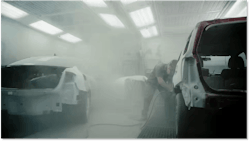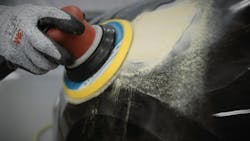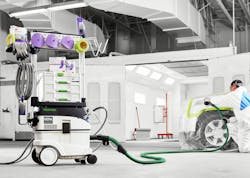For dust extraction, the time is now
One of my colleagues, Travis Lamb, attended an industry event not long ago when he struck up a conversation with an OEM engineer. As automakers pack more and more data, devices, and connectivity into today’s cars, the engineer let him know of a new concern that’s cropping up. Digital electronic interference? Travis asked. Sunspots? None of the above. Instead, the new threat is distinctly old-school: dust.
Dust has been part of the car experience since Model T drivers wore goggles. What could be new about it now?
It's not only its nature, but also its targets. Replacing engine and cabin air filters is a familiar need, but in a modern car, dust comes from new sources and can cause problems in many other places: from cameras and sensors to onboard computers and wiring harnesses. Dust gets into terminals and wiring pigtails when they’re unplugged, then stays there when they’re reconnected, silently grinding away. Protect those connections with dielectric grease? The dust sticks to that and hangs on.
That’s in a conventional car. Add in the battery arrays in an electric or hybrid car, with all of their high-voltage connections and vulnerabilities, and dust has yet another playing field.
One other thing about dust that wasn’t true 100 years ago: Not all of it comes from the road. A major source of airborne particulates is bodywork, where grinding and sanding sends microscopic bits of paint and metal into the air. The body shop isn’t only a source of dust; it’s also a potential dust victim. Dust can shorten the lives of abrasives, diminish the quality of work, sully the workplace, and introduce health hazards for employees.
Travis wasn’t surprised that he heard about this from a carmaker, since body shops in North America don’t always give dust extraction the attention it deserves. For a variety of reasons, too many of today’s shops have a negative view of dust extraction (DE) technologies: they may have had bad experiences in the past, they view the hardware as a luxury, they aren’t familiar with the latest developments. Or they think dust extraction is cost-prohibitive. Only about one in five shops in the U.S. and Canada have a DE system in place. Dust extraction is not used as heavily in the U.S. and Canada as it is in Europe due to a lack of regulations, where capturing possibly toxic dust is not only valued, but is regulated.
It doesn’t have to be this way — and really, it shouldn’t.
Go back to cars’ onboard systems for a moment. When dust-containing metal gets inside sensitive electronics, it can cause short circuits, or heat buildup that can lead to failure or even fire. It’s true that today’s touchscreen interfaces let in less dust than yesterday’s dials and push-buttons — but the systems they control have more connections and cables, each of which presents a dust vulnerability. No body shop team wants to send a car out in a worse state than when it came in, but too much dust may create that risk.
Then there’s the shop itself. Dust is a respiratory health threat to workers, and particulates from materials like body filler, composites, or fiberglass strands can sometimes be harmful. Dust contributes to a dirty workplace and drives up the time and cost of keeping the shop clean. Dust that collects on a workpiece can cause defects in the final finish. Dust on the sanding surface can shorten the life of the very abrasives that create it.
How modern dust extraction systems solve traditional drawbacks
Over the years, shop dust extraction hardware has evolved. Admittedly, older systems justified some of the reluctance shop owners feel today. The first generation of dust extractors simply consisted of large vent hoods, not unlike those in restaurant kitchens. The dust eventually left the room, but not before it hung around for a while. Later, individual units allowed repair workers to bring a vacuum head from a central vacuum system right up to the work. But adding dust extraction hoses to the mix of air lines, electric cords and tools could create a cluttered workspace.
Those days are gone. Running a modern shop without dust extraction is like navigating a big city with a 30-year-old map.
Today's advanced abrasive systems and dust extraction technology make avoiding dust-related problems not only easier but cost-effective. Dust extraction sanders and compatible abrasives allow more than 90 percent of sanding dust to be captured as it is created. Modern systems use portable dust extractors that are more affordable and versatile than older central vacuum systems, especially for collision repair where every job is different.
3M and Festool have collaborated to introduce a sanding system that combines the toolmaker's potent sanders and portable dust extractors with faster-cutting 3M abrasives. And we aren’t the only ones.
If you’re a body shop owner, you know why some repairs trigger rework. Imperfectly finished surfaces and not-quite-there paint jobs are certainly on that list.
Imagine the productivity-building benefit of less rework, better abrasive performance and life, and skilled workers spending less time on non-productive work like sweeping floors and wiping down repairs. Imagine providing a cleaner work environment for your employees. That's not to mention the sensitive electronics on every car that could cause long-term issues.
Before you ask how much a modern dust extraction system may cost, ask how much it costs you not to have one. When you add up all the benefits, there’s a good chance it will pay for itself.
About the Author
David Woods
David Woods is a senior global program delivery manager for the 3M Automotive Aftermarket Division.


